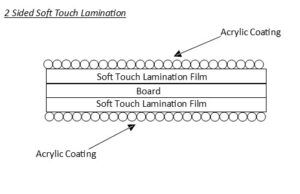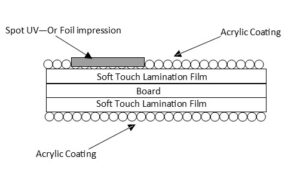I am often asked this question and here I will try
to explain the reasons for this phenomenon.
Soft touch film’s are coated with an acrylic layer
and for the purposes of this article, I want you
to imagine that if you magnified the surface it
would look like a film covered in tiny soft globules.

When you spot varnish or foil onto the soft
globule surface, the targeted area becomes
coated and creates a slightly raised surface.
This area becomes much harder than the
acrylic coating and changes the surface composition of that area on the sheet.

As the sheets are processed and start to form a
pile in the machine stacker, the sheets with a now
harder and slightly more raised surface area where
the foil or spot uv image is situated, press against
the soft acrylic globules on the sheet above and
make an impression on the soft touch coating.

This has just enough pressure to slightly change
the surface area of the soft touch coating on the
bottom of the sheet and can be seen as a colour
fade or a dulling of the soft touch coating shaped
exactly the same as the image it is pressed
against. Here you can see how the varnished area
has flattened down the acrylic coating to create a
ghosting effect.

Conclusion
Soft touch film’s are a fantastic way to add value, and increase the feel of quality to your products, and used in
the correct way continue to be one of the most luxurious and functional films available on the market today.
The nature of the soft acrylic coating creates a really soft almost rubbery or velvety feel and is highly recommended in the use of decorative print finishing.
The Ghosting effect only happens on two sided work assuming spot uv or foil is applied. When planning artwork
with your customers this should be discussed and pointed out to them to avoid disappointment later. It should
be explained that the soft acrylic coating can be changed or effected by harder materials such as uv varnish and
foil.
Alternately there are films available that have been modified by the manufacturers to compensate for this phenomenon, by reducing the softness of the acrylic coating – however this then takes away the soft nature of the
film to some degree and may not then achieve the expected results.

